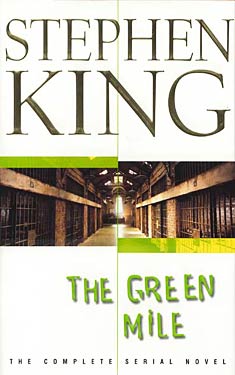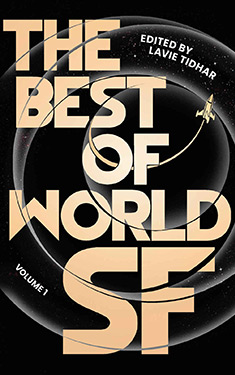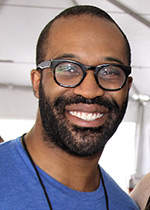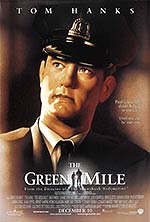
Added By: Administrator
Last Updated: Administrator
The Green Mile
| Author: | Stephen King |
| Publisher: |
Signet, 1996 |
| Series: | |
|
This book does not appear to be part of a series. If this is incorrect, and you know the name of the series to which it belongs, please let us know. |
|
| Book Type: | Novel |
| Genre: | Horror |
| Sub-Genre Tags: | Psychic Abilities Psychological Ghosts |
| Awards: | |
| Lists: | |
| Links: |
|
| Avg Member Rating: |
|
|
|
|
Film & Television Adaptations
Synopsis
Set in the 1930s at the Cold Mountain Penitentiary's death-row facility, The Green Mile is the riveting and tragic story of John Coffey, a giant, preternaturally gentle inmate condemned to death for the rape and murder of twin nine-year-old girls. It is a story narrated years later by Paul Edgecomb, the ward superintendent compelled to help every prisoner spend his last days peacefully and every man walk the green mile to execution with his humanity intact.
Edgecomb has sent seventy-eight inmates to their date with "old sparky," but he's never encountered one like Coffey -- a man who wants to die, yet has the power to heal. And in this place of ultimate retribution, Edgecomb discovers the terrible truth about Coffey's gift, a truth that challenges his most cherished beliefs -- and ours.
Excerpt
Chapter One
This happened in 1932, when the state penitentiary was still at Cold Mountain. And the electric chair was there, too, of course.
The inmates made jokes about the chair the way people always make jokes about things that frighten them but can't be gotten away from. They called it Old Sparky, or the Big Juicy. They made cracks about the Power bill, and how Warden Moores would cook his Thanksgiving dinner that fall, with his wife, Melinda, too sick to cook.
But for the ones who actually had to sit down in that chair, the humor went out of the situation in a hurry I presided over seventy-eight executions during my time at Cold Mountain (that's one figure I've never been confused about; I'll remember it on my deathbed), and I think that, for most of those men, the truth of what was happening to them finally hit all the way home when their ankles were being damped to the stout oak of "Old Sparky's" legs. The realization came then (you would see it rising in their eyes, a kind of cold dismay) that their, own legs had finished their careers. The blood still ran in them, the muscles were still strong, but they were finished, all the same; they were never going to walk another country mile or dance with a girl at a barn-raising. Old Sparky's clients came to a knowledge of their deaths from the ankles up. There was a black silk bag that went over their heads after they had finished their rambling and mostly disjointed last remarks. It was supposed to be for them, but I always thought it was really for us, to keep us from seeing the awful tide of dismay in their eyes as they realized they were going to die with their knees bent.
There was no death row at Cold Mountain, only E Block, set apart from the other four and about a quarter their size, brick instead of wood, with a horrible bare metal roof that glared in the summer sun like a delirious eyeball. Six cells inside, three on each side of a wide center aisle, each almost twice as big as the cells in the other four blocks. Singles, too. Great accommodations for a prison (especially in the thirties), but the inmates would have traded for cells in any of the other four. Believe me, they would have traded.
There was never a time during my years as block superintendent when all six cells were occupied at one time -- thank God for small favors. Four was the most, mixed black and white (at Cold Mountain, there was no segregation among the walking dead), and that was a little piece of hell. One was a woman, Beverly McCall. She was black as the ace of spades and as beautiful as the sin you never had nerve enough to commit. She put up with six years of her husband beating her, but wouldn't put up with his creeping around for a single day. On the evening after she found out he was cheating, she stood waiting for the unfortunate Lester McCall, known to his pals (and, presumably, to his extremely short-term mistress) as Cutter, at the top of the stairs leading to the apartment over his barber shop. She waited until he got his overcoat half off, then dropped his cheating guts onto his tu-tone shoes. Used one of Cutter's own razors to do it. Two nights before she was due to sit in Old Sparky, she called me to her cell and said she had been visited by her African spirit-father in a dream. He told her to discard her slave-name and to die under her free name, Matuomi. That was her request, that her deathwarrant should be read under the name of Beverly Matuomi. I guess her spirit-father didn't give her any first name, or one she could make out, anyhow. I said yes, okay, fine. One thing those years serving as the bull-goose screw taught me was never to refuse the condemned unless I absolutely had to. In the case of Beverly Matuomi, it made no difference, anyway. The governor called the next day around three in the afternoon, commuting her sentence to life in the Grassy Valley Penal Facility for Women -- all penal and no penis, we used to say back then. I was glad to see Bev's round ass going left instead of right when she got to the duty desk, let me tell you.
Thirty-five years or so later -- had to be at least thirty-five -- I saw that name on the obituary page of the paper, under a picture of a skinny-faced black lady with a cloud of white hair and glasses with rhinestones at the comers. It was Beverly. She'd spent the last ten years of her life a free woman, the obituary said, and had rescued the small-town library of Raines Falls pretty much single-handed. She had also taught Sunday school and had been much loved in that little backwater. LIBRARIAN DIES OF HEART FAILURE, the headline said, and below that, in smaller type, almost as an afterthought: Served Over Two Decades in Prison for Murder. Only the eyes, wide and blazing behind the glasses with the rhinestones at the comers, were the same. They were the eyes of a woman who even at seventy-whatever would not hesitate to pluck a safety razor from its blue jar of disinfectant, if the urge seemed pressing. You know murderers, even if they finish up as old lady librarians in dozey little towns. At least you do if you've spent as much time minding murderers as I did. There was only one time I ever had a question about the nature of my job. That, I reckon, is why I'm writing this.
The wide corridor up the center of E Block was floored with linoleum the color of tired old limes, and so what was called the Last Mile at other prisons was called the Green Mile at Cold Mountain. It ran, I guess, sixty long paces from south to north, bottom to top. At the bottom was the restraint room. At the top end was a T-junction. A left turn meant life -- if you called what went on in the sunbaked exercise yard life, and many did; many lived it for years, with no apparent ill effects. Thieves and arsonists and sex criminals, all talking their talk and walking their walk and making their little deals.
A right turn, though -- that was different. First you went into my office (where the carpet was also green, a thing I kept meaning to change and not getting around to), and crossed in front of my desk, which was flanked by the American flag on the left and the state flag on the right. On the far side were two doors. One led into the small W.C. that I and the E Block guards (sometimes even Warden Moores) used; the other opened on a kind of storage shed. This was where you ended up when you walked the Green Mile.
It was a small door -- I had to duck my head when I went through, and John Coffey actually had to sit and scoot. You came out on a little landing, then went down three cement steps to a board floor. It was a miserable room without heat and with a metal roof, just like the one on the block to which it was an adjunct. It was cold enough in there to see your breath during the winter, and stifling in the summer. At the execution of Elmer Manfred -- in July or August of '30, that one was, I believe -- we had nine witnesses pass out.
On the left side of the storage shed -- again -- there was life. Tools (all locked down in frames crisscrossed with chains, as if they were carbine rifles instead of spades and pickaxes), dry goods, sacks of seeds for spring planting in the prison gardens, boxes of toilet paper, pallets cross-loaded with blanks for the prison plate-shop...even bags of lime for marking out the baseball diamond and the football gridiron -- the cons played in what was known as The Pasture, and fall afternoons were greatly looked forward to at Cold Mountain.
On the right -- once again -- death. Old Sparky his ownself, sitting up on a plank platform at the southeast comer of the storeroom, stout oak legs, broad oak arms that had absorbed the terrorized sweat of scores of men in the last few minutes of their lives, and the metal cap, usually hung jauntily on the back of the chair, like some robot kid's beanie in a Buck Rogers comic-strip. A cord ran from it and through a gasket-circled hole in the cinderblock wall behind the chair. Off to one side was a galvanized tin bucket. If you looked inside it, you would see a circle of sponge, cut just right to fit the metal cap. Before executions, it was soaked in brine to better conduct the charge of direct-current electricity that ran through the wire, through the sponge, and into the condemned man's brain.
Copyright © 1996 by Stephen King
Reviews
Images
No alternate cover images currently exist for this novel.



















 Full Details
Full Details











